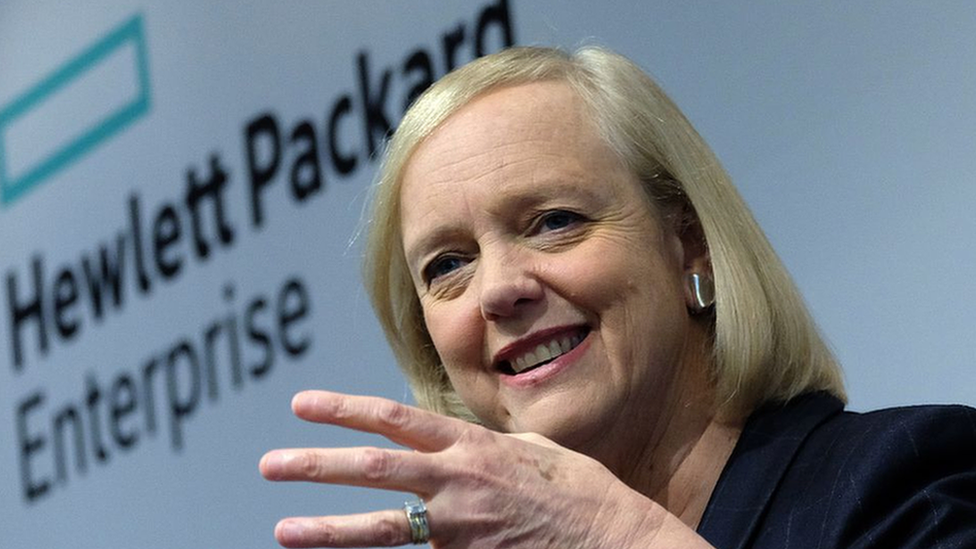Meg Whitman: Why I decided to shrink Hewlett-Packard
- Published

"The future belongs to the fast," is how Meg Whitman explains her radical decision as chief executive to split up technology giant Hewlett-Packard.
The firm, which famously started life in a Palo Alto garage in California in 1939 and which is credited with founding Silicon Valley - the beating heart of the hi-tech world - has now declared a new era: that of the nimble start-up.
By 2014, when Ms Whitman announced HP's decision to separate its computer and printer business from its corporate hardware and services operations, the company had grown into a lumbering colossus.
The firm was focused on desktop computers and printers, as demand for mobiles and tablets was taking off.
Its fortunes started to decline with a series of expensive and much criticised acquisitions, including Compaq for $25bn in 2002, consultants EDS for $14bn in 2008 and Autonomy for $11bn in 2011.
By 2012 it had lost its position as the world's leading supplier of PCs to Lenovo.
The dramatic split was aimed at helping the firm adapt to the new era of mobile and online computing, responding to shareholder demands for more aggressive growth.
"Our decision was that we needed to separate first into two companies, because a $110bn company working in 170 countries... we were never going to be fast enough to lead the market in which we compete," says Ms Whitman.
She now heads the new spin-off, Hewlett Packard Enterprise, which sells servers and services.
The firm is still a sizeable company with annual revenues of about $50bn (£40bn), but nonetheless this is still about half of what the old HP generated.
Being bigger isn't necessarily considered better
Ms Whitman says the change, which took place in 2015, has already improved her performance.
"I would go from laser jet printing to our big enterprise services contracts where we were running the back end of IT for many big companies and organisations. These two things are not like each other.
"So the ability to focus and engage with customers on a narrow set of objectives and business outcomes... I can already see the difference," she says.
One big change, she says, is it allows each of the divisions to pursue the strategy that is right for them.
For example, she says there is "no way" printer and PC company HP Inc's decision last year to buy Samsung's printing business for $1bn would have happened when it was part of the larger firm.
"We would have allocated a billion dollars for a cloud or big data analytics or the next generation of software to find infrastructure. So it's that ability to drive your own agenda, not hindered by other businesses that don't have the same characteristics [which is the advantage]," she says.
Ms Whitman is so convinced her strategy is working that she's shrunk HPE further, spinning off both its business services division and its software business into separate companies last year.
Her assumption that bigger doesn't always mean better seems surprising.
After all, a larger company should find it easier to dominate the market it operates in.
But the rapid rise of much smaller start-ups, rivalling and often overtaking these established behemoths means the accepted wisdom that size equals success is being challenged, and not just by HPE.
For example, media firms News Corporation and Time Warner have both split off their print businesses into separate firms, aiming to accelerate the growth of their broadcast arms.
Similarly in 2014, eBay - also formerly led by Ms Whitman - split into two, carving PayPal, the electronic payments arm it bought in 2001, off from the main online auction business.
CEO coach and author Steve Tappin says such moves reflect a shift in management thinking.
"For a long time, growing big seemed best in business, with great scale giving great buying power. Today, things are different - large enterprises are often too slow, and are overtaken by smaller disruptive firms."

Box founder Aaron Levie says despite the firm's rapid growth it still tries to behave in the same way as when it was smaller
Box is a case in point. The cloud storage company, which allows users to upload files and access them no matter where they are or on what device, was founded in 2005.
Founder Aaron Levie says the product - which doesn't require users to install or download any software - was " inadvertently very disruptive to the traditional technology companies".
"Whether [you're] Uber, Airbnb, Spotify or Netflix - those same lessons apply. Which is if you can build something that's cheaper, faster and more scalable and delivers a far better customer experience than what the traditional vendors or incumbents were able to do, then you can be extremely disruptive," he says.
The firm now employs 1,400 people, but Mr Levie says it still aims to behave in the same way as it did when it had just 20 staff members to keep its entrepreneurial mindset.
It is something Ms Whitman is also trying to achieve at HPE.
"The bigger you are the harder it is to be fast, because you've got so many people involved in every decision. Our view was - given the backdrop of the technology industry - [being] smaller [and] more focused was going to be important," she says.
This feature is based on interviews by CEO coach and author Steve Tappin, and by series producer Neil Koenig, for the BBC's CEO Guru series.